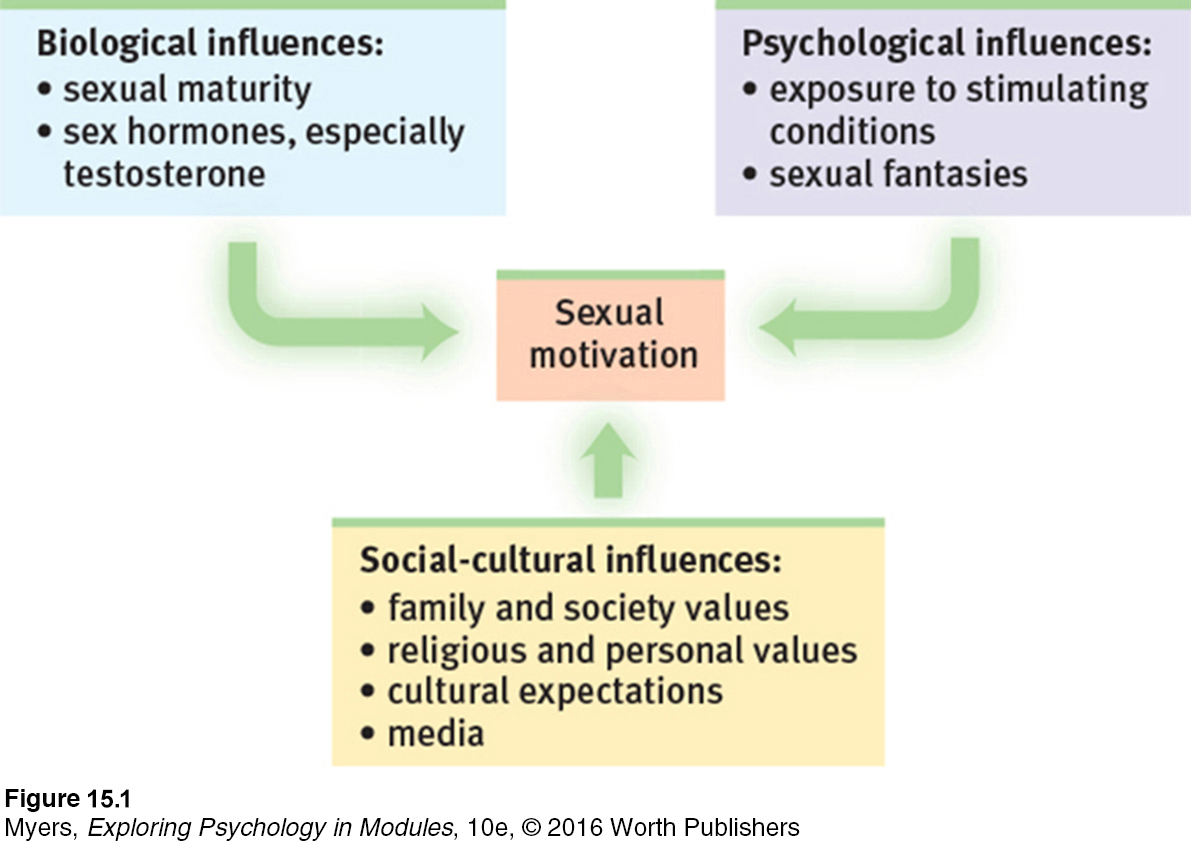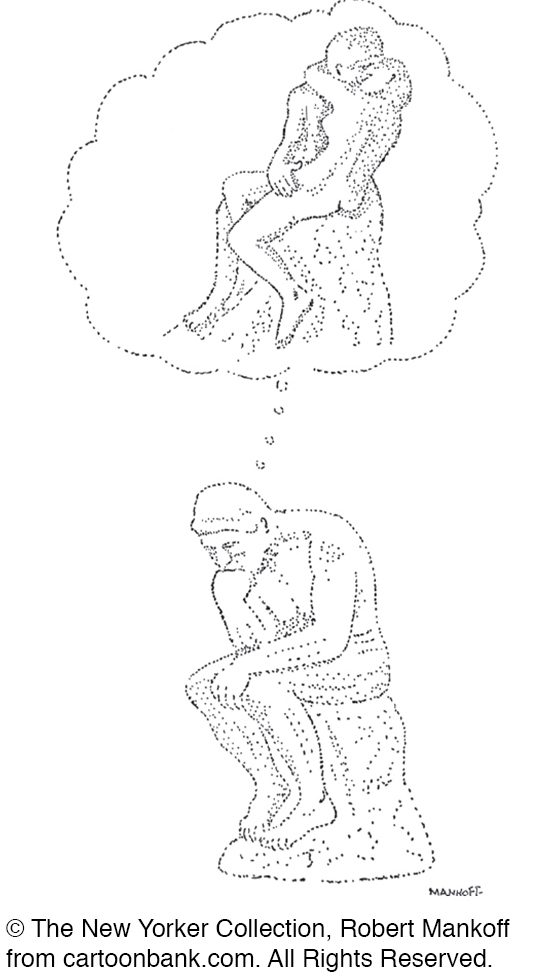15.2 The Psychology of Sex
15-

Biological factors powerfully influence our sexual motivation and behavior. Yet the wide variations over time, across place, and among individuals document the great influence of psychological factors as well (FIGURE 15.1). Thus, despite the shared biology that underlies sexual motivation, 281 expressed reasons for having sex ranged widely—

External Stimuli

Men and women become aroused when they see, hear, or read erotic material (Heiman, 1975; Stockton & Murnen, 1992). In 132 experiments, men’s feelings of sexual arousal have much more closely mirrored their (more obvious) genital response than have women’s (Chivers et al., 2010).
People may find sexual arousal either pleasing or disturbing. (Those who wish to control their arousal often limit their exposure to such materials, just as those wishing to avoid overeating limit their exposure to tempting cues.) With repeated exposure, the emotional response to any erotic stimulus often lessens, or habituates. During the 1920s, when Western women’s rising hemlines first reached the knee, an exposed leg was a mildly erotic stimulus.
Can exposure to sexually explicit material have adverse effects? Research has indicated that it can:
Rape acceptance Depictions of women being sexually coerced—
and liking it— have increased viewers’ belief in the false idea that women enjoy rape, and have increased male viewers’ willingness to hurt women (Malamuth & Check, 1981; Zillmann, 1989). Devaluing partner Viewing images of sexually attractive women and men may also lead people to devalue their own partners and relationships. After male college students viewed TV or magazine depictions of sexually attractive women, they often found an average woman, or their own girlfriend or wife, less attractive (Kenrick & Gutierres, 1980; Kenrick et al., 1989; Weaver et al., 1984).
Diminished satisfaction Viewing X-
rated sex films has similarly tended to reduce people’s satisfaction with their own sexual partner (Zillmann, 1989). Perhaps reading or watching erotica’s unlikely scenarios may create expectations that few men and women can fulfill.
Imagined Stimuli

The brain, it has been said, is our most significant sex organ. The stimuli inside our heads—
Wide-
RETRIEVE IT
Question
What factors influence our sexual motivation and behavior?
Teen Pregnancy
15-
Compared with European teens, American teens have a higher rate of STIs and also of teen pregnancy (Call et al., 2002; Sullivan/Anderson, 2009). What environmental factors contribute to teen pregnancy?
Minimal communication about birth control Many teenagers are uncomfortable discussing contraception with their parents, partners, and peers. Teens who talk freely with parents, and who are in an exclusive relationship with a partner with whom they communicate openly, are more likely to use contraceptives (Aspy et al., 2007; Milan & Kilmann, 1987).
Guilt related to sexual activity Among sexually active 12-
Alcohol use Most sexual hookups (casual encounters outside of a relationship) occur among people who are intoxicated, with an impaired ability to give and comprehend consent (Fielder et al., 2013; Garcia et al., 2013). Those who use alcohol prior to sex are less likely to use condoms (Kotchick et al., 2001). By depressing the brain centers that control judgment, inhibition, and self-
“Condoms should be used on every conceivable occasion.”
Anonymous
social script culturally modeled guide for how to act in various situations.
Mass media norms of unprotected promiscuity Perceived peer norms influence teens’ sexual behavior (van de Bongardt et al., 2015). Teens attend to other teens, who, in turn, are influenced by popular media. Media help write the social scripts that affect our perceptions and actions. So what sexual scripts do today’s media write on our minds? Sexual content appears in approximately 85 percent of movies, 82 percent of television programs, 59 percent of music videos, and 37 percent of music lyrics (Ward et al., 2014). Twenty percent of middle school students, and 44 percent of 18-
Media influences can either increase or decrease sexual risk taking. One study asked more than a thousand 12-
Later sex may pay emotional dividends. One national study followed participants to about age 30. Even after controlling for several other factors, those who had later first sex reported greater relationship satisfaction in their marriages and partnerships (Harden, 2012). Several other factors also predict sexual restraint:

High intelligence Teens with high rather than average intelligence test scores more often delayed sex, partly because they considered possible negative consequences and were more focused on future achievement than on here-
and- now pleasures (Halpern et al., 2000). Religious engagement Actively religious teens have more often reserved sexual activity for adulthood (Hull et al., 2011; Lucero et al., 2008).
Father presence In studies that followed hundreds of New Zealand and U.S. girls from age 5 to 18, a father’s absence was linked to sexual activity before age 16 and to teen pregnancy (Ellis et al., 2003). These associations held even after adjusting for other adverse influences, such as poverty. Close family attachments—
families that eat together and where parents know their teens’ activities and friends— also predicted later sexual initiation (Coley et al., 2008). Participation in service learning programs Several experiments have found that teens volunteering as tutors or teachers’ aides, or participating in community projects, had lower pregnancy rates than were found among comparable teens randomly assigned to control conditions (Kirby, 2002; O’Donnell et al., 2002). Researchers are unsure why. Does service learning promote a sense of personal competence, control, and responsibility? Does it encourage more future-
oriented thinking? Or does it simply reduce opportunities for unprotected sex?
RETRIEVE IT
Question
What factors contribute to unplanned teen pregnancies?